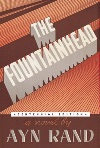 I am a philosopher, and when I’m on the job I have been known to read literary works as “premises with feet.” Despite that occupational hazard I am also fascinated with how some great fiction writers can seamlessly integrate abstract philosophical themes with concrete literary portrayals.
I am a philosopher, and when I’m on the job I have been known to read literary works as “premises with feet.” Despite that occupational hazard I am also fascinated with how some great fiction writers can seamlessly integrate abstract philosophical themes with concrete literary portrayals.
When I teach Ayn Rand’s The Fountainhead, my focus in class is philosophical but I do like to point out along the way how her fiction-writer’s methods concretize, dramatize, and foreshadow her abstract themes. One example:
On the premise that first meetings matter immensely in life and literature, let’s look at our first meetings of Howard Roark and Peter Keating.
At the beginning of Chapter 1, we meet Roark:
“He stood naked at the edge of a cliff. …
“His body leaned back against the sky. It was a body of long straight lines and angles, each curve broken into planes. He stood, rigid, his hands hanging at his sides, palms out. He felt his shoulder blades drawn tight together …
“He was looking at the granite.
“He did not laugh as his eyes stopped in awareness of the earth around him …
At the beginning of Chapter 2, Keating is introduced. He is graduating top of his class, and the distinguished architect Guy Francon is giving the address:
“The hall was packed with bodies and faces, so tightly packed that one could not distinguish at a glance which faces belonged to which bodies. It was like a soft, shivering aspic made of mixed arms, shoulders, chests, and stomachs. One of the heads, pale, dark haired and beautiful belonged to Peter Keating.
“He sat, well in front, trying to keep his eyes on the platform because he knew that many people were looking at him and would look at him later. He did not glance back, but the consciousness of those centered glances never left him.”
The contrasts so far:
* Roark is by himself and his body is described in singular terms. Keating is indistinguishable in the midst of a crowd.
* Roark’s conscious focus is on nature. Keating’s consciousness is focused on other people’s watching him.
* Roark is naked. Keating is robed and capped in conventional graduation attire.
So right from the beginning we are introduced to Roark’s individualism and his orientation to reality; we are introduced to Keating’s collectivity and his social metaphysics; and we are invited by Rand to contrast the two directly.
Side note for another post: On the premise that who gets the first and word matters in life and literature: In The Fountainhead the first words are “Howard Roark” and the last words are …
For me the Fountainhead has been one the best books I have ever read and Howard Roark the perfect model of a human being in his honesty, integrity, and belief in the supremacy of human spirit over all other values usually honored in life: power in all its worldly manifestations, wealth, public opinion, and most importantly blind acceptance of what has been inherited from the past.
Nicely stated, Abraham. I appreciate the spirit of your post.